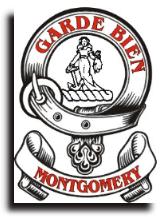

The Scottish Montgomery family originally came from Normandy. They held a castle called Sainte Foy de Montgomery in Calvados, Normandy and Roger de Mundergumbrie was rewarded for his support of William the Conqueror in 1066 with the Earldom of Shrewsbury in England. The first Montgomery in Scotland was Robert, a grandson of the Earl, who was granted lands in Eaglesham in Renfrewshire. He probably came to Scotland with Walter Fitzalan, the first high steward of Scotland in the reign of King David I. He died around 1177. The Eaglesham property remained with the family until the 19th century.
Sir John Montgomery, the 7th Baron of Eaglesham, was a hero at the Battle of Otterburn in 1388. He fought Sir Henry Percy (also known as Hotspur) hand to hand and was responsible for capturing the English knight. He obtained a large ransom as a result, which allowed him to build Polnoon Castle (Polnoon Street is still one of the main thoroughfares in the village of Eaglesham). He also married the heiress of Sir Hugh Eglinton which gave him the Barony of Eglinton and Ardrossan.
Sir John's grandson was created Lord Montgomery in 1449. The 3rd Lord Montgomery supported Prince James in the rebellion against his father, King James III and as a result was granted the island of Arran and keepership of Brodick Castle. These were later taken over by the Hamiltons.
Lord Montgomery became earl of Eglinton in 1507 and, after escaping from the defeat of the Scottish army by the English at the Battle of Flodden in 1513, participated in the Parliament at Perth which proclaimed James V king (aged eighteen months).
There was a long-running feud between the Montgomeries and the Cunninghams. It began over a relatively minor matter but continued over the centuries, despite legal judgements and government action. The Eglinton manor house was burned early in the 16th century and the 4th Earl was killed by the Cunninghams. The government of King James VI eventually managed to get the rival chiefs to shake hands.
During the Reformation, the 3rd Earl remained a staunch Catholic and supported Mary Queen of Scots. He escorted her back from France after the death of her first husband, the King of France. He fought for her at the Battle of Langside in 1568 and was subsequently imprisoned for treason. Religion continued to pose problems when the 6th Earl, a devout Protestant, fought on the side of the Covenanters against King Charles I in the middle of the 17th century. He was later captured and then imprisoned until the Restoration of King Charles II in 1660.
A branch of the Scottish Montgomeries settled in Donegal in Ireland in 1628 and Viscount Montgomery of Alamein came from this line.
The 12th Earl of Eglinton rebuilt Eglinton Castle and was created a peer of the United Kingdom in 1806 as Baron Ardrossan of Ardrossan. The 18th Earl of Eglinton also has the titles of Lord Montgomerie, Lord Seton and Tranent, Earl of Winton and Baron Ardrossan of Ardrossan as well as Hereditary Sheriff of Renfrewshire.
The Montgomery clan motto is "Garde bien" which means "Watch well".
There is a Montgomery clan Web sites here.



